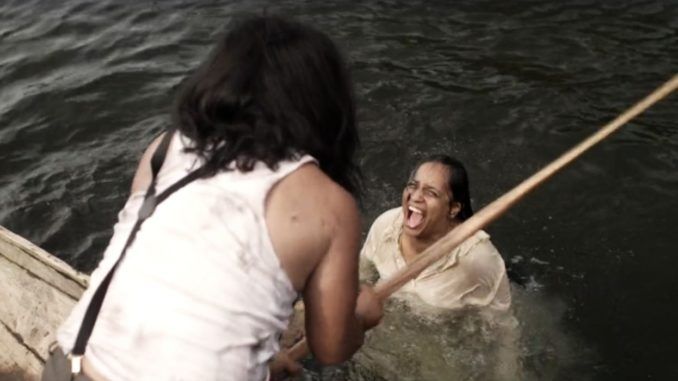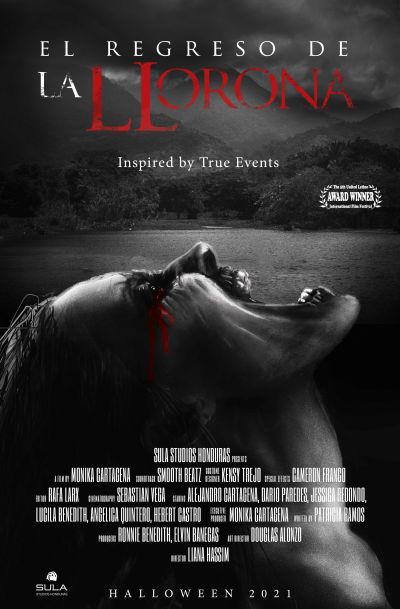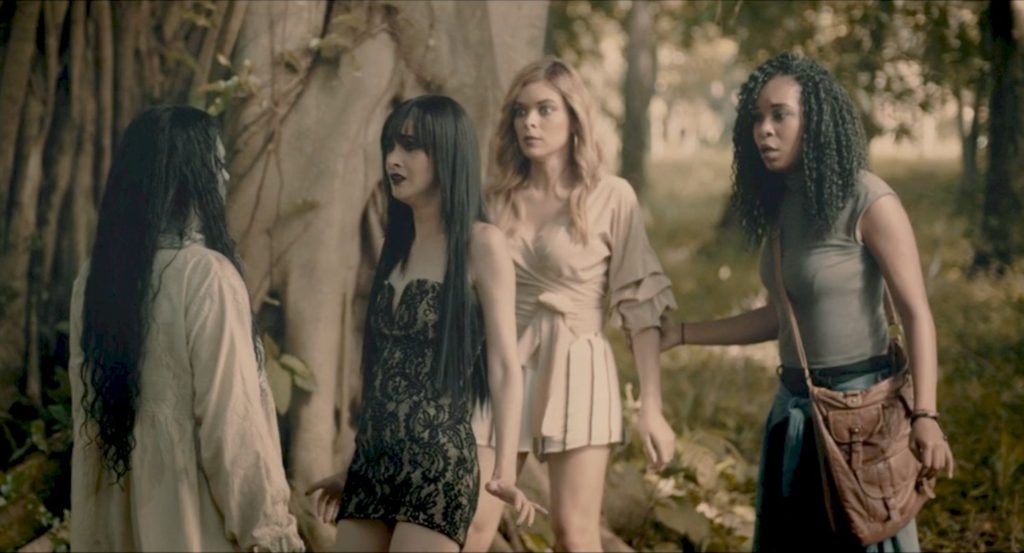
Rating: C-
Dir: Liana Hassim
Star: Lucila Benedith, Jessica Redondo, Dario Paredes, Angelica Quintero
a.k.a. Return of the Weeping Woman
La Llorona is a well-known legend from Latin American folklore, one whose origins date back to before the Spaniards arrived. The most common version of the story, concerns a native woman who drowns her children and kills herself after discovering her husband (or lover) had been unfaithful to her. For these sins – and probably suicide more than the infanticide – her soul is doomed to wander in perpetuity, forever roaming the riverbanks, weeping for her lost children, and luring the unwary to their deaths. Per Wikipedia, “Recurring themes in variations on the La Llorona myth include a white, wet dress, nocturnal wailing, and an association with water.” It’s often used as a boogeyman (or woman, I guess) to stop children playing near potentially dangerous stretches of terrain.
Given such a strong central concept and imagery, you won’t be surprised to learn it has frequently been the inspiration for movies. The first was 1933’s Mexican film, La Llorona, but it was certainly not the last. A search on Tubi alone currently finds no fewer than eleven different Llorona-flicks, including one which shares its title with (but is definitely not), the best-known of the bunch. That’s the James Wan production, The Curse of La Llorona, which took in $123 million worldwide in 2019, despite costing less than $10 million. Maybe I’ll end up doing 31 Days of La Llorona for 2025. For now though, the usual rule applies: where one cheapish, profitable horror film goes, many cheaper entries will inevitably follow.
 This is at least authentically sourced from local ingredients, being made in Honduras. It’s one of those Central American countries on the isthmus between Mexico and South America. Specifically, the first one below Mexico. I’m not sure I could tell you much about it, culturally, except it’s not the one with the canal in it. The earliest domestic Honduran film, Mi Amigo Ángel, was made in 1962 and ran barely for 30 minutes. The first successful local horror feature was 2002’s Almas de la Media Noche (Souls of Midnight), in which six students investigate the death of a journalist. But the country didn’t submit any movies for Oscar consideration until 2017.
This is at least authentically sourced from local ingredients, being made in Honduras. It’s one of those Central American countries on the isthmus between Mexico and South America. Specifically, the first one below Mexico. I’m not sure I could tell you much about it, culturally, except it’s not the one with the canal in it. The earliest domestic Honduran film, Mi Amigo Ángel, was made in 1962 and ran barely for 30 minutes. The first successful local horror feature was 2002’s Almas de la Media Noche (Souls of Midnight), in which six students investigate the death of a journalist. But the country didn’t submit any movies for Oscar consideration until 2017.
Safe to say this one will not be troubling the Academy. Which is actually a bit frustrating, because there are points where the film seems to be doing the right things, only then to stall and lose all momentum. It opens well enough, with a flashback to the origins of the legend. Though in the version here, la llorona is very much the victim, not the perpetrator. A woman and her two children are in their riverside home, cowering from her abusive husband, who knocks the woman out, grabs one of the kids and heads off in his boat. The woman tries to follow, only to be knocked out with an oar (top) and presumably drown, along with the child. While not graphic, it’s rough to watch.
Unfortunately, it sets a standard the rest of the film is woefully unable to match. From here, things grind to a halt for close to thirty minutes as we meet the largely irritating and uninteresting group of friends we’ll be following. They are spending a few days at the house belonging to one of them, Julio (Paredes), located in the unfortunately named Sambo Creek. As well as Julio, the others include his pals Tavo and Martin, his overly attached girlfriend Rocio (Redondo) and blonde babe Micaela (Quintero). Off elsewhere is Rosa (Benedith), the serious one who’d be a dead cert for Final Girl, if she didn’t come on as a sub at half-time. She’s busy writing an article, which her editor wants to be about the legend of La Llorona. She wants it to be about femicide.
So instead of being at the beach house, she’s hanging out in the local emergency room, talking to her doctor pal. He’s a believer in la llorona, having met her when he was a kid. Again, him telling this anecdote is a simple yet effective moment… followed by extended, teeth-grinding tedium of the friends at a nightclub. This is actually tedium necessary to the plot, in that Julio picks up a woman there, takes her back to the house and they have sex. She’s rather less into it when his two friends barge in and it becomes an unscheduled foursome. The victim of this sexual assault flees and while they’re chasing her down in the woods, she gets run over and killed. This triggers la llorona into revenge mode.
 Well, such as it is. The first sign of this Julio deciding to stick his hand, off-camera, into a blender. Yeah. Because that makes total sense, in terms of.. whatever. It might have done, had it been the first in a series of escalating punishments. Except, it’s not really. After leaving hospital, for reasons best described as vague, Julio does end up pouring petrol on himself, dying in a blaze of unconvincing CGI fire. I’m not even sure what happened to Tavo. There were a lot of noises off and he was then lying on the floor, while Micaela emoted to no great effect. At least Martin drowns, in accordance with the traditional fate of la llorona‘s victims. [In line with the feminism on view, the women are untouched, beyond a vaguely creepy encounter, above]
Well, such as it is. The first sign of this Julio deciding to stick his hand, off-camera, into a blender. Yeah. Because that makes total sense, in terms of.. whatever. It might have done, had it been the first in a series of escalating punishments. Except, it’s not really. After leaving hospital, for reasons best described as vague, Julio does end up pouring petrol on himself, dying in a blaze of unconvincing CGI fire. I’m not even sure what happened to Tavo. There were a lot of noises off and he was then lying on the floor, while Micaela emoted to no great effect. At least Martin drowns, in accordance with the traditional fate of la llorona‘s victims. [In line with the feminism on view, the women are untouched, beyond a vaguely creepy encounter, above]
It’s mostly dull, and all very sloppy, not least at the ending where it goes from the middle of the night to broad daylight in five seconds, with only a shot of a rising moon to justify it. A bunch of soldiers show up, we cut to a news report about four corpses showing up (which doesn’t make sense either, because Julio was nowhere near the others when he died), and Rosa wins a road-race before a Halloween parade. But it seems la llorona is still on the prowl, ready to trigger suicide in men who say mean things to women. Ooh, I’m so scared.
This review is part of our October 2024 feature, 31 More Countries of Horror.
